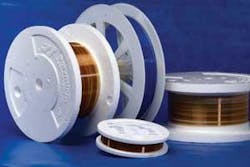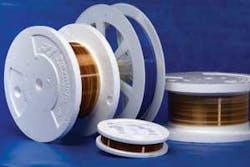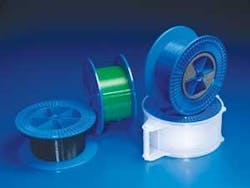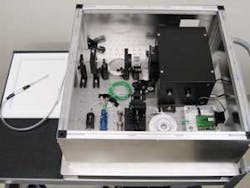FIBERS FOR HARSH ENVIRONMENTS: Special fibers address environmental challenges
JOE ZHOU and JOHN SHANNON
Standard communications and other off-the-shelf fibers are generally designed for benign environments and will fail under harsh operating conditions. For these situations, “specialty” optical fibers are designed with properties tailored to address the specific operating conditions (see Fig. 1). An understanding of the relevant fiber properties and characteristics of the harsh environment will enable a system designer to select a fiber that best meets system performance specifications while withstanding environmental exposure and meeting cost targets. There are so many design options available that a system designer should consult with a specialty-fiber manufacturer early in the design stage. Proper fiber selection at the onset reduces development time and often results in a more robust and cost-effective system.Properties of optical fibers
Each application has its own set of conditions so a fiber solution that works in one situation may not work in another. There are a number of specific fiber properties that should be considered when trying to optimize fiber performance for a harsh environment.
The strength of an optical fiber is governed by the quality of the glass and glass surface of the fiber. Fiber must be prescreened for any “weak links” during the fabrication process, ensuring at least a minimum strength over the entire length of fiber. This screening process is known as proof testing. Typical large-core multimode fibers have a proof strength level of 50 to 100 kpsi. Silica optical fibers experience stress fatigue, which is a reduction in strength over time caused by a combination of ambient moisture ingression and stress that causes crack growth on the glass surface. Stress on a fiber can arise from tension, bending, or torsion.
A key function of the polymeric coating on an optical fiber is to isolate the glass surface from any solid contact, thereby preserving the high-quality surface and ensuring the fiber’s mechanical durability. If the coating is compromised, then so is the glass surface, thus reducing the fiber strength. Damage to the polymeric coatings will render the proof test meaningless. However, the damage can be reduced or eliminated with properly designed protective measures, such as extruded jackets of various materials and steel strip-wound tubes.
Another key parameter of fiber is the attenuation of propagated optical power. The spectral attenuation depends on the operating wavelength. The desired wavelength(s) of operation must be considered when selecting the core and cladding materials of the fiber. Light propagating down a fiber experiences extra loss when the fiber is bent tightly. The additional attenuation due to fiber bending is known as bending loss or macro bending loss. When a fiber receives uneven forces from the side, it can exhibit additional attenuation, termed micro bending loss, due to localized small bending over the length of the fiber.
The polymer coating or jacket that provides chemical and mechanical protection to the fiber can potentially out-gas. Out-gassing in a vacuum is a severe problem and can cause contamination in thin-film deposition chambers. In a space application, out-gassing can cloud detection windows and lenses, causing a potential mission threatening failure. Some polymer coating materials soften or even dissolve in certain chemical containing environments. Some do not even withstand the chemicals commonly used in optic cleaning procedures, such as alcohol or acetone. Coating dissolution exposes silica glass in the fiber to moisture attack or mechanical damage, thus weakening the fiber. Another important consideration when fiber is used in medical applications is biocompatibility. Optical fibers must be made of biocompatible materials and must also be capable of withstanding common sterilization procedures, such as autoclave or ethylene oxide (ETO).
Design considerations
Fiber optics are expected to operate under harsh conditions that can range from high temperature to ionizing radiation, or a combination thereof. In applications such as combustion sensing, autoclave sterilization, and chemical process monitoring, in which the fiber will be subjected to high temperature, the coatings selected will limit the temperature range of the fiber. For temperatures above 150°C, a polyimide or silicone coating would be good choices. Silicone can withstand up to 200°C while a polyimide coated fiber withstands continuous temperatures up to 350°C and intermittently up to 400°C. However, silicone being very soft would require an additional layer of extruded ETFE or PFA. For temperatures above 400°C a metal coating would be required but is considerably more expensive than polyimide. Polyimide is also quite chemically resistant, which is often desired in high-temperature applications.
Coatings are also a factor when low temperature (below -40°C) is a consideration, such as in cryogenic research and space vehicles. The thermal mismatch between the various coating layers and the glass, as well as coating glass transition temperatures, can cause a dramatic increase in attenuation at low temperatures. Thinner coatings with lower glass transition temperatures and fewer coating layers will generally improve performance. Again, polyimide coating would be a good selection for extreme low temperatures ranging from -40°C to -196°C (cryogenic liquid nitrogen).
High-humidity applications, such as mobile platforms and autoclave sterilization, can accelerate mechanical fatigue of the fiber. This will only be the case if there is stress present. A higher fiber proof-test level will improve the margin of safety. If a hermetic coating is needed, then the options are a carbon or metal coating, which will dramatically increase the cost and can cause other issues such as difficulty in termination or higher optical losses in the fiber.
Medical procedures, industrial robot arms, mobile-platform datacom, and sensing often require the fibers to withstand stress or a small bend radius, which can affect optical loss and mechanical failure. If optical loss is the concern, generally a higher NA fiber will be selected. Polymer-clad fibers (hard clad or silicone clad) offer a cost-effective solution, with a relatively high NA (0.37 to 0.48). For higher NAs, a borosilicate or all-plastic optical fiber (POF) would be needed. These fibers can be very cost effective but will have other concerns such as much higher optical loss, limited wavelength range, and poorer mechanical and thermal performance. Glass-clad fiber with NAs up in the 0.37 range are available, but the cost increases dramatically above 0.24 NA. If mechanical failure is the concern, then higher proof-test levels ensure a higher baseline starting strength. In tight bend situations, a smaller fiber glass diameter should be considered because a smaller fiber will generate less bending stress for a given bend radius. Again, a higher proof-test level would provide an additional safety margin.
Abrasion is often a factor in industrial and military deployments, as well as some medical procedures. Fibers with an extruded jacket such as ETFE, nylon, or polyester are generally the best choice for applications where the fiber will experience high abrasion. If a fiber with a thin coating, such as hard clad or polyimide, or a softer coating, such as silicone or acrylate, is desired, then an extruded jacket can often be added to improve the abrasion resistance. The added jacket will increase cost, however, and can compromise other parameters such as temperature performance and size (diameter) restrictions. An extruded jacket must always go over another polymeric layer, and not be applied directly onto the glass surface.The key issue in in vivo medical applications, which include plaque ablation in arteries, kidney stone lithotripsy, and eye surgery, is biocompatibility and containment of the laser power in the fiber. A dual clad (glass clad/hard clad/ETFE) is often the fiber of choice. In this design the hard-clad optical polymer has a lower refractive index than the silica material and acts as a secondary cladding that confines some of the light traveling inside the primary silica cladding back to the core that otherwise can be lost. The hard optical polymer coating makes the fiber capable of handling increased optical power with less risk of “hot spots” in tight bends. As a result, the fiber exhibits lower bending loss and thus is suitable for use in the restricted space environments common in medical procedures. The extruded ETFE jacket is chemically inert (similar to Teflon), sterilization-ready, and biocompatible.
Materials cutting and welding and laser surgery require high laser power and cover a wide range of output conditions and application requirements. The best approach is to consult with fiber manufacturers who specialize in fibers capable of handling high-power input. For medium- to high-power applications, large-diameter hard-clad fibers (larger than 200 µm core diameters) are cost efficient, effective, and robust (see Fig. 2). If the power level is higher than the hard clad alone can handle, then a dual clad is a better choice. The glass clad can handle higher power and the hard clad helps to contain the power down the length and also allows an extruded jacket such as ETFE to be applied for improved durability.
When fibers will be used in a vacuum, such as in data links and sensors in a space vehicle and thin-film deposition systems, the key concern is out-gassing from the polymer coatings and the type of coating material must be chosen carefully. Thinner, more-stable coatings, such as polyimide will tend to outgas less under vacuum conditions. In some cases the amount of out-gas is finite, so a pre out-gas can be performed on the fiber before it is installed in the application.
Chemical exposure can occur in chemical analysis in a process stream, industrial process controls, automotive, and homeland security hazards analysis. Fiber performance is dependent on the coating materials selected because there are few chemicals that will effectively attack silica glass. Extruded jacket materials, such as ETFE or PFA, are very inert and can be an effective chemical block. However, care must be taken not to expose the fiber ends because the chemical will often wick up underneath the extruded layer thereby compromising the fiber. Polyimide is also quite chemical resistant and is often used in direct chemical exposure situations.
Some applications involve exposure to UV or nuclear radiation. These include spectroscopy/lithography, solar collection, sensors in nuclear reactors, and detectors for accelerators and military vehicles. Fiber performance is typically dependent on glass properties. Because of increased radiation-induced defects in the core, silica can experience dramatic attenuation increases under the radiation, rendering the fiber useless. For UV wavelengths below about 350 nm, a high –OH-content-core/glass-clad fiber can be used. For UV wavelengths below about 250 nm or under nuclear radiation, the choice of fiber type can be complex, so it’s best to consult directly with a fiber manufacturer who specializes in UV transmitting fibers or radiation resistant fibers.
Joe Zhou is a product manager and John Shannon is engineering manager at Polymicro Technologies, 18019 N. 25th Ave. Phoenix, AZ 85203; e-mail: [email protected]; www.polymicro.com.



